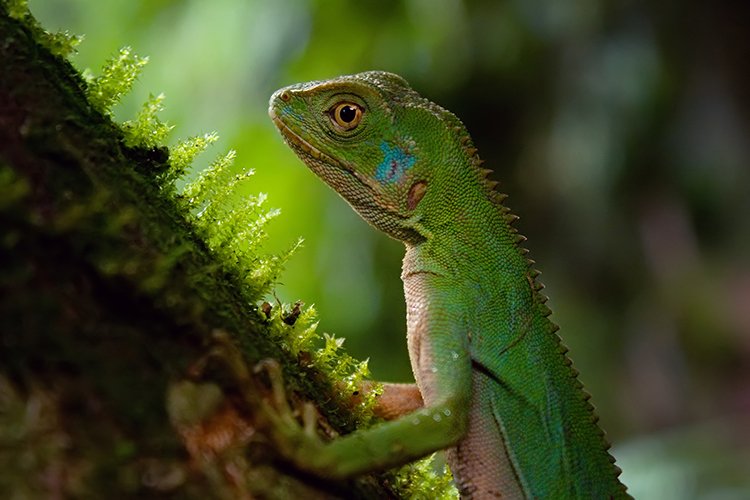Nippy Iguanas
Guillermo Garcia Mendive-Mario G. Alvarez, Public domain via Wikimedia Commons
Leiosauridae
by Inspector Barry Mins on November 14, 2022Hey kids, welcome back to our series on the mysteries of created kinds. Last week we met horses. This week we move from mammals to reptiles and move south into Central and South America.

Like other reptiles, this kind needs to warm up and stay warm to remain active. If it gets too cold, these lizards will slow down or stop.1 Cold temperatures will also cause the strength of their bite to decrease, making it harder for them to hunt.2 Most members of the kind prefer living in forests, with some being arboreal (living in trees).3 They love munching on insects, but the diet differs between species, with some preferring ants while others prefer caterpillars and cockroaches.4 Despite being primarily arboreal, they are also not above hunting on the ground.5 Nor are they above eating each other if the opportunity arises.6
In some species, males are more colorful than females and, in theory, more susceptible to predators. However, males are quicker to run from predators, perhaps compensating for being easier to see.7 Males and females are often different in size as well.8
Has anyone figured it out yet? This week’s kind is the Leiosauridae—the South American iguanas. Stay tuned for next week when we look for some very noticeable water birds.

João P. Burini, CC BY-SA 4.0 via Wikimedia Commons
Try out this fun word search!
Clue
Your clue for the week is:
This bird kind is known for standing in or around slow-moving water to look for food.
Ask a Question
Have you ever had a question about created kinds but didn’t know who to ask? Have you ever wanted to learn more about your favorite kind? Well, now you can! You can ask me, Inspector Barry Mins, a question! Have your parents help you fill out this form, and you might get your question answered in my column! If you have any questions about created kinds, feel free to send them my way!
Footnotes
- R. G. Ales, J. C. Acosta, F. Valdez, T. A. Martinez, R. Acosta, M. J. R. Munoz, R. Fernandez, and L. Corrales, “Comparative thermal ecophysiology in Pristidactylus scapulatus populations from the Puna region of Argentina,” Zoology 145, (2021).
- N. Vicenzi, A. Laspiur, P. L. Sassi, R. Massarelli, J. Krenz, and N. R. Ibarguengoytia, “Impact of temperature on bite force and bite endurance in the leopard iguana (Diplolaemus leopardinus) in the Andes Mountains,” Journal of Experimental Biology 223, (2020).
- K. C. M. Pellegrino, M. T. Rodrigues, C. E. V. Bertolotto, R. C. Amaro, Y. Yonenaga-Yassuda, and E. M. X Freire, “Molecular phylogeny, species limits, and biogeography of the Brazilian endemic lizard genus Enyalius (Squamata: Leiosauridae): An example of the historical relationship between Atlantic Forests and Amazonia,” Molecular Phylogenetics and Evolution 81, (2004): 137–146.
- “Ecological comparisons between the sympatric lizards Enyalius bilineatus and Enyalius brasiliensis (Iguanidae, Leiosaurinae) from an Atlantic rain forest area in southeastern Brazil,” Journal of Herpetology 39, no. 3 (2005): 504–509.
- C. Zamprogno, M. D. G. F. Zamprogno, and R. L. Teixeira, “Evidence of terrestrial feeding in the arboreal lizard Enyalius bilineatus (Sauria, Polychrotidae) of south-eastern Brazil,” Zoology 61, no. 1 (2001).
- M. del Milagro Torres, L. J. Viladrich, and S. Naretto, “A case of cannibalism in Achala copper lizard Pristidactylus achalensis, an endemic lizard to the highest mountain areas in central Argentina (Squamata: Leiosauridae),” Herpetology Notes 12, (2019): 827–828.
- M. del Milagro Torres, L. J. Viladrich and S. Naretto, “Role of coloration in antipredator strategies of Pristidactylus achalensis (Squamata: Leiosauridae) related to sex and stages of predation,” Biological Journal of the Linnean Society 133, no. 3 (2021): 896–909.
- S. Naretto and M. Chiaraviglio, “Factors driving sexual dimorphism and colour variability in Achala Copper Lizard (Pristidactylus achalensis), an endemic species to the highland mountains in Central Argentina,” Canadian Journal of Zoology 98, no. 6 (2020).
- © 2024 Answers in Genesis
- Privacy Policy
- Contact
- About
